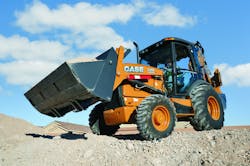Reprinted with the permission of Equipment Manager magazine, the magazine of AEMP.
Tire management provides an ongoing challenge for construction equipment fleets. To a greater extent than most components and systems, tire lifecycle and maintenance requirements are determined by the machine’s applications and working conditions, which can vary widely depending on the scope of the fleet’s projects.
Tires play a key role in the productivity of construction equipment. Minimizing or eliminating tire problems can have a significant impact on uptime and job completion. While many fleet managers choose to rely on in-house resources for tire maintenance and replacement, others have found success in partnering with their equipment dealers to define tire-management strategies that maximize their investment and minimize downtime.
Consider that a flat tire even on a small machine will cost an average of four hours downtime—not to mention maintenance or replacement costs—and you get a sense of the importance of selecting the right tires and providing proper maintenance.
Tire use and lifecycle
Manufacturers usually equip their machines with standard tires designed for the most typical applications the machine will perform. A fleet manager can rely on his equipment dealer for advice on choosing the right tires, based on a number of factors.
McCann Industries, a Case dealership in Bolingbrook, Ill., offers equipment managers strategic advice as well as service and support concerning tire selection, maintenance and eventual replacement.
“Tire life can be as little as 500 hours or as much as 1,500 or more hours, depending on the applications,” says Richard Hoffmeyer, product support manager, McCann Industries. “We can help the fleet manager understand the various scenarios of tire lifecycles and choose tires that make the most sense from the standpoint of purchase price, expected maintenance costs and eventual replacement costs. In operating environments that are extremely hostile, we may recommend that the customer not spend extra money on premium tires, based on the understanding that no matter how good the tires are, they’ll need to be replaced at frequent intervals.”
Although tire dealers also can provide advice and support, many fleet managers decide to rely on their equipment dealer for their tire service and support. This one-source approach not only streamlines record-keeping and accounts payable processes; it ensures that a qualified, professional service team is providing comprehensive support and making recommendations within the overall context of the machine’s condition and remaining productive lifespan.
“When you rely on the dealer for tire service, you will have access to the tire-maintenance records that will help you make decisions about getting the most life out of the tires and eventually replacing them at the optimum time,” Hoffmeyer says. “And at trade-in, the machine will have more complete maintenance records. That helps assure the next buyer of the machine’s value and the care that it has received.”
Hostile conditions pose challenges for tires
When machine applications call for working in hostile conditions, the costs of tire maintenance and replacement can mount quickly, in terms of both dollars and downtime. Some specialized solutions are available to minimize these costs.
For example, equipment managers increasingly are using solid tires to enhance productivity, improve uptime and minimize tire maintenance expense for machines working in hazardous conditions. Solid tires are priced at a premium over pneumatic tires, but they offer equipment managers an important strategic advantage: They last a long time on the job. Their longer lifespan translates to savings in maintenance expense and savings in replacement costs.
“Solid tires are not just for skid steers,” Hoffmeyer says. “We’re also seeing many customers order them for wheel loaders and loader/backhoes working in extreme conditions, like recycling, scrap handling, junk yards and demolition. They last three or more times longer than pneumatics and reduce tire maintenance such as inflation problems and blowout repairs.”
Similar to solid tires are foam-filled pneumatic tires. Although they add some protection, foam-filled tires also add weight to the machine, which can strain the axles and transmissions. Foam-filled tires weigh more than flexible solid tires, which also weigh more than pneumatic tires. In contrast, solid tires typically weigh within the allowable operating specs of the machine.
Fleet managers may consider other options for protecting tires working in hazardous conditions. These include tire-chain systems, which also provide traction assistance in slippery operating conditions, and a system of interlocking metal rings referred to as “mail” that is several inches thick and keep tires clear of hazards such as hot metal in steel mills.
Extended tire maintenance coverage
Fleet managers can obtain extended service and maintenance programs through their equipment dealers over and above typical OEM warranties. These programs may include physical damage insurance for tires, covering vandalism, accidents and other instances of damage requiring tire replacements.
This extended coverage adds some costs, but typically it is much less than the cost of replacing the tires on any piece of wheeled equipment.
Although it may not seem like a component of strategic tire management, fleet managers should consider equipping construction vehicles with smart GPS systems that can track hours of usage and miles traveled, both of which figure into tire replacement cycles.
Keeping spare tires available is essential. Many if not most operators are capable of handling a tire change on the job site, if a spare is available. This can be a big time saver and a way to minimize downtime. Here again is a situation where the dealer can help a contractor manage: The dealer can be on call for changing tires, or can be used as a dispatch service to send a third-party tire dealer to the job site for a quick tire change and replacement.
Defining and implementing the right tire-management strategy will help minimize costs and downtime, and maximize productivity and profit.
Eric Metzger is product marketing manager, parts &
service, for Case Construction Equipment.
